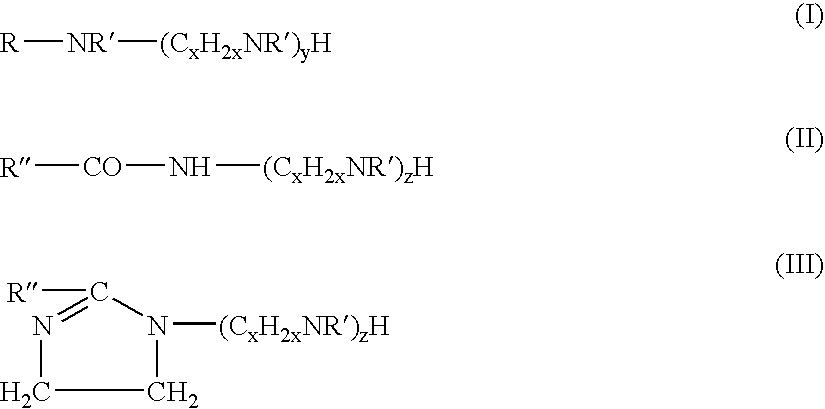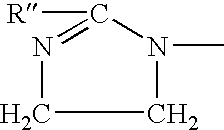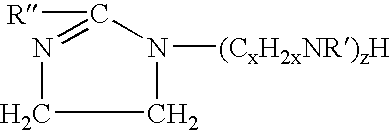Oil Base Fluids and Organophilic Tannin-Containing Compositions to Lower the Fluid Loss Thereof
a technology of organophilic tannins and base fluids, which is applied in the direction of sealing/packing, wellbore/well accessories, chemistry apparatus and processes, etc., can solve the problems of reducing the dispersibility of filter cake or sludge thus formed, reducing the dispersion of oil, and high cost of oil loss to the formation. , to achieve the effect of low fluid loss
- Summary
- Abstract
- Description
- Claims
- Application Information
AI Technical Summary
Benefits of technology
Problems solved by technology
Method used
Image
Examples
example 1
[0064]Two organophilic wattle-containing compositions were prepared as follows: Sample 1-1. 100 grams of Black Wattle extract were mixed with 1000 cc of water and heated to 76.7±° C. for one hour. 20 g of concentrated sulfuric acid were added and mixed 5 minutes. 30 g of Partial Amide A was added and mixed for 15 minutes. 1.43 g of commercial lecithin were added and mixed 5 minutes. 32 g of lime were added and mixed 5 minutes. Thereafter, the slurry was filtered and the filter cake dried at 65.6° C. before grinding the samples to pass through a 60 mesh screen. Sample 1-2. Prepared as Sample 1-1 except that 30 g of sulfuric acid and 48 g of lime were used. The Black Wattle extract was obtained from The Tannin Corp., Peabody, Mass.
example 2
[0065]Two organophilic quebracho-containing compositions were prepared as in Example 1 except that quebracho extract was substituted for the wattle extract and alkylamidoimidazoline B was substituted for the partial amide A. The quebracho extract was obtained from the Unitan SA, Buenos Aires, Argentina.
[0066]The samples of examples 1 and 2 and the commercial organophilic lignite, DURATONE, were evaluated as fluid loss control additives in VASSA LP-90, Conoco LVT 200, or diesel oils as follows: 15 grams of sample were mixed with 350 ml of oil for 10 minutes in an Osterizer mixer; the initial API fluid loss of the fluid was then measured; the remaining fluid was poured out of the filtration cell into an Osterizer mixer and mixed with the filtrate and the filter cake for 10 minutes to reconstitute the fluid; the fluid was then hot rolled for 16 hours at 148.9° C. (300° F.) and / or 176.7° C. (350° F.) as set forth in Table 1; the fluid was cooled to room temperature and the API fluid los...
example 3
[0068]Six organophilic quebracho-containing compositions were prepared as in Example 1 containing various concentrations of partial amide A as set forth in Table 3, and the concentrations of sulfuric acid, lime and commercial lecithin used for Sample 1-1. These samples were evaluated as fluid loss control additives at 14.25 kg / m3, 28.5 kg / m3, or 42.75 kg / m3 at (5, 10, or 15 ppb) in the VASSA LP-90 paraffinic oil, the BIOBASE internal olefin, and diesel oil after shearing 10 minutes in an Osterizer mixer. The data obtained are set forth in Table 3.
[0069]The data indicates the excellent lowering of the fluid loss in the various oils particularly when the concentration of the partial amide in the OTCC is greater than about 15% by weight, based on the weight of the tannin extract.
PUM
| Property | Measurement | Unit |
|---|---|---|
| temperatures | aaaaa | aaaaa |
| volume percent | aaaaa | aaaaa |
| specific gravity | aaaaa | aaaaa |
Abstract
Description
Claims
Application Information
 Login to View More
Login to View More - R&D
- Intellectual Property
- Life Sciences
- Materials
- Tech Scout
- Unparalleled Data Quality
- Higher Quality Content
- 60% Fewer Hallucinations
Browse by: Latest US Patents, China's latest patents, Technical Efficacy Thesaurus, Application Domain, Technology Topic, Popular Technical Reports.
© 2025 PatSnap. All rights reserved.Legal|Privacy policy|Modern Slavery Act Transparency Statement|Sitemap|About US| Contact US: help@patsnap.com



